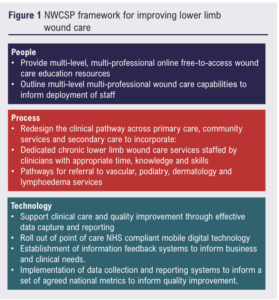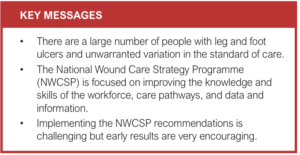EDITORIAL
National Wound Care Strategy Programme: past, present and future
Adderley U1
Introduction
Wound care consumes a considerable proportion of NHS resources, particularly for services that deliver healthcare outside hospitals.1 It is estimated that around 50% of community nursing time is spent delivering wound care.2 The burden is considerable for people living with wounds who too often cannot access the right care early enough in their wound care journey. As we move through the Covid pandemic towards recovery, the need to improve wound care is more pressing than ever.
Past
In 2018, the NHS England Nursing Directorate commissioned the National Wound Care Strategy Programme (NWCSP) to be delivered by the Academic Health Science Network (AHSN).3 The aim of the NWCSP is to develop and implement a strategy for improving wound care with a particular focus on lower limb wounds (leg and foot ulcers), pressure ulcers and surgical wounds.
Early work identified that leg and foot ulcers account for the largest number of patients and the largest proportion of NHS spend. The NWCSP estimated in 2019 that there were 739,000 leg ulcers in England with an associated annual healthcare costs of £3.1 billion.4 A large proportion of these ulcers are due to venous insufficiency for which there is a strong evidence base in favour of compression therapy and endovenous ablation for promoting healing and preventing recurrence.5,6 The NWCSP also identified that there are at least as many people with foot ulcers but without diabetes as there are people with diabetic foot ulcers, and that more than half of all major lower limb amputations are in people who do not have diabetes.7 The healthcare needs for both groups are very similar, but without diabetes it is difficult to access the necessary care early to reduce the risk of amputation and death. This, coupled with unwarranted variation in evidence-based care, made improving lower limb care a NWCSP priority.
In 2020 the NWCSP published its Recommendations for Lower Limb Care.8 In 2021 this was followed by a business case for implementing the NWCSP Lower Limb Recommendations.4 The business case detailed:
• Projected prevalence of chronic lower limb wounds and associated NHS costs.
• The degree to which care can be improved through service change along with the potential clinical and patient benefits.
• The potential economic and financial benefits from such improvement.
• Potential costs of implementation.
• Possible time scales to realise the stated benefits.
Due to the lack of robust data about foot ulceration, the business case was built on the evidence for venous and ‘mixed venous/arterial leg ulcers’, but makes a convincing case of benefit for all those with leg and foot ulcers and for the NHS as a healthcare provider. It predicts that improving wound care and thus improving healing, reducing recurrence and reducing amputation rates would lead to improved physical and psychological health for patients and incur less time and money spent attending clinical appointments.
For the NHS, improving lower limb wound care offers financial benefits equivalent to a net present value of £14.6bn and a benefit cost ratio of 9.8 over 30 years through a predicted 30% reduction in leg ulcer prevalence. The business case also predicts a reduction in the consumption of clinical time and equipment which, when the cost of implementation is included, will deliver an estimated £7.8bn of net cash releasing savings. This is equivalent to a 9% cash saving on the NHS cost of leg and foot ulcer care in England. It also predicts £6.8bn of non-cash releasing savings (efficiencies) from an estimated 23% reduction in clinical time spent on lower limb ulcer care which will increase staff capacity. There is also expected to be an immediate in-year 11% reduction in the cost of dressings and wound care products.9
Present
In 2021 the NWCSP began to recruit seven ‘first tranche implementation sites’ (‘FImps’) to implement the NWCSP Recommendations for Lower Limb Ulcers. The aim was to test the assumptions of the NWCSP business case and to develop ‘blueprints’ to guide wider adoption and spread. This FImp work continues but, in early 2022, the AHSN selected implementation of the NWCSP lower limb wound recommendations as one of its new national programmes.9 The NWCSP is now working in partnership with the Academic Health Science Network (AHSN) Transforming Wound Care (TWC) programme to achieve wider implementation.10
For Phase 1, the AHSN TWC programme is working with six AHSNs (East Midlands, Eastern, Health Innovation network (South London), Kent, Surrey Sussex, Oxford and South West) to each recruit an initial Test and Evaluation Site (TES). Phase 2 is expected to start at the end of 2022 and will include the remaining AHSNs in England.
In April 2022 the NWCSP was invited to present its lower limb wound work to the NHS England National Productivity Board. The NWCSP and AHSN TWC programme is now working with the NHS England Transformation Directorate to develop a strategy for accelerating implementation across England.
Working closely with the seven regional FImp sites and the AHSN TWC programme, the NWCSP is developing a lower limb ‘bundle’ structured around people, process and technology (Figure 1). Together with the NHS England Transformation Directorate, different options for accelerated implementation are being considered, with the focus on implementation at regional/local level.

Future
Progress is encouraging and the FImps are already seeing dramatic improvements in healing rates which are reducing community workforce pressures. However, there is still some way to go before everyone with a lower limb wound gets the care they need sufficiently early in their wound care journey.
People
Improving the knowledge and skills of the workforce is a priority, so a multi-professional, multi-level capability framework for wound care has been developed to help organisations identify the capabilities required of their workforce.11 In terms of education, the universities already provide high quality Tier 3 postgraduate level wound care courses for those with responsibility for advanced wound care (such as tissue viability nurse specialists), but wound care is currently a low priority in most pre-registration clinical education programmes despite most registered clinicians regularly caring for people with wounds.
The NWCSP view is that it is inappropriate for the NHS to rely on education provided by wound product suppliers to fill this gap, so has developed a suite of online free-to-access educational resources.12 The Tier 1 resources are for those who require a fundamental level of wound care (such as general practitioners and those working in community services and in acute care). The Tier 2 resources are for those requiring more advanced knowledge (such as those working in dedicated lower limb services). The resources are also highly suitable for use in pre-registration clinical programmes and the NWCSP is striving to raise awareness amongst providers of such programmes.
The NWCSP recognises that online education resources need to be complemented by experiential learning, so a lower limb wound ‘curriculum’ is also being developed to guide the development of local wound care education programmes. Some early adopters of the NWCSP recommendations for lower limb wounds are already using the NWCSP capability framework for wound care to identify the required wound care capabilities for their whole workforce, and have added the online learning resources to their mandated education requirements. The experience of the FImps has also revealed the need for protected clinical educator time to support improving wound care knowledge and skills across the workforce.
There is also an urgent need for high quality information resources for patients and carers. The NWCSP website signposts to trusted independent resources such as Legs Matter to help improve the public’s knowledge and lower limb health,13 but in addition is working with the Patient Experience Network, patients and carers to co-create information resources for patients and carers. These will be published on the NWCSP website.3
Process
It has also become apparent that, even in organisations committed to improving lower limb care, there is considerable unwarranted variation in pathways of care. While some variation is to be expected, earlier identification of those in need of care, standardisation of the core elements of care and the development of closer links with relevant services are needed. Too many patients with lower limb lymphoedema cannot access lymphoedema services and too many non-diabetic patients with foot ulceration cannot access podiatry or orthotics services or are referred too late to vascular services.
There appears to be a mixed pattern in relation to referrals for endovenous ablation for venous disease. In some areas patients are being refused referral while, in other areas, vascular surgical services are swamped by referrals, only a proportion of which are suitable for surgery. The situation is exacerbated by a shortage of vascular surgical staff. The NWCSP and the Vascular Services Quality Improvement Programme (VSQIP) have together developed draft referral templates for both venous and arterial disease, and these are now being trialled by the FImps in the hope that this will improve the situation and identify further necessary work.
Technology
Finally, the NWCSP is addressing the challenge of the lack of data about lower limb wounds. Many clinicians have attempted to improve lower limb care in their organisations only to see their new services disbanded when NHS cuts hit. Quality improvement initiatives require accurate and timely data and information, so the NWCSP is committed to supporting clinical care and quality improvement through effective data capture and reporting.
The NWCSP is recommending roll-out of point-of-care NHS compliant mobile digital technology that replaces paper clinical notes with electronic clinical record-keeping. Such systems also need to have information feedback systems to inform business and clinical needs and to eventually provide clinical decision support.
The data situation is further complicated by the current lack of agreed national metrics and the myriad of codes that are currently used in wound care. This means it is impossible to know the size of the lower limb wound patient population or other information such as treatment, healing rates or rates of recurrence. Implementing robust data collection and reporting systems to inform a set of agreed national metrics is essential to inform quality improvement initiatives. Other digital initiatives encouraged by the NWCSP include the increased use of e-referrals, digital imaging to monitor wound healing and digitally supported self-care.
Conclusion
Looking ahead, although much has been achieved, there is still much to do. Moving into implementation is challenging, particularly in the current climate with so many demands on the NHS. However, improving lower limb wound care will not only help make the best possible use of NHS resources, but it will dramatically improve the quality of life for the many people who live with leg and foot ulcers.

Article DOI:
Journal Reference:
J.Vasc.Soc.G.B.Irel. 2022;2(1):4-6
Publication date:
November 21, 2022
Author Affiliations:
1. National Wound Care Strategy Programme, Manchester, UK
Corresponding author:
Una Adderley
Director, National Wound Care Strategy Programme, Health
Innovation Manchester,
Citylabs 1.0, Nelson Street,
Manchester M13 9NQ, UK
Email: [email protected]











